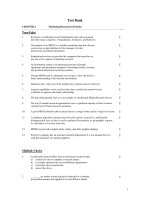Lecture Marketing research (12th edition) - Chapter 8: Information collection: Qualitative and observational methods
Bạn đang xem bản rút gọn của tài liệu. Xem và tải ngay bản đầy đủ của tài liệu tại đây (295.63 KB, 19 trang )
Marketing Research
Aaker, Kumar,
Leone and Day
Twelfth Edition
Instructor’s
2
Chapter Eight
Information Collection:
Qualitative and
Observational Methods
Marketing Research 12th Edition
3
Marketing Research
Marketing Research
Primary
Qualitative
Secondary
Quantitative
3
Qualitative
Quantitative
Marketing Research 12th Edition
4
Information Collection :
Qualitative and Observational Methods
Marketing Research 12th Edition
5
Qualitative Research Methods
Marketing Research 12th Edition
6
Qualitative Research Methods (Contd.)
•
Four major constraints:
▫
Volume of data
▫
Complexity of analysis
▫
Detail of clarification record
▫
Timeconsuming nature of the clerical efforts required
Computer technology helps alleviate these problems and
increase the use of qualitative research
•
Marketing Research 12th Edition
7
Use of Computers in Qualitative Research
Marketing Research 12th Edition
8
Individual Indepth Interviews
•
Nondirective interviews
▫
•
Respondent given maximum freedom to respond
Semistructured or focused individual interviews
▫
Covers a specific list of topics or subareas
Individual indepth interview techniques
1.
Laddering
2.
Hiddenissue
3.
Symbolic Analysis
Marketing Research 12th Edition
9
Focus Group Discussions
•
•
Offers participants more stimulation
than an interview; makes new ideas
and meaningful comments more
likely
Issues to be addressed:
▫
Outlining the intended direction of
the group
▫
Explaining how participants were
recruited
▫
Reeducating observers on the
concepts of random selection,
statistical reliability, and
Marketing Research 12th Edition
10
Types of Focus Groups
Marketing Research 12th Edition
11
Key Factors for Focus Group Success
ü
Planning the Agenda
ü
Recruitment
ü
Moderator
ü
Analysis and
Interpretation of the
Results
Marketing Research 12th Edition
12
Trends in Focus Groups
•
Telephone Focus Groups
•
Video Conference
•
Twoway focus groups
•
Online focus groups
Marketing Research 12th Edition
13
Ten Tips for Running a Successful Focus
Group
Most client organizations conduct more focus
1.
2.
You can never do too much
planning for a focus group
Manage the recruitment
process actively to get the right
people in the groups
7.
groups than are necessary to achieve the
research objective
9.
10.
3.
4.
Don’t prejudge the participants
based on physical appearance
The best focus group
moderators bring objectivity
and expertise to a project
11.
One of the most important services a
moderator can provide is a fast report
turnaround
Client observers should be thoroughly
briefed about research objectives before the
sessions start
The most valuable service a moderator can
provide is objective conclusions based on the
interpretations of the research, without
regard for what the client wants to hear
Marketing Research 12th Edition
14
Projective Techniques
•
Presentation of an ambiguous, unstructured
object, activity, or person that a respondent is
asked to interpret and explain.
Categories of Projective Techniques
•
•
•
•
•
•
•
Word Association
Completion Test
Picture Interpretation
Third Person Techniques
Role Playing
Case Studies
Other Projective Techniques like
Photo Sort., Pictured Aspirations
Technique (PAT), etc.
Marketing Research 12th Edition
15
Limitations of Qualitative Methods
•
•
•
Potential susceptibility of the results to get misused or
misinterpreted
Results not necessarily representative of the whole
population
Moderator or interviewer's role is extremely critical
and can lead to ambiguous or misleading results
Marketing Research 12th Edition
16
Observational Methods
Ø
Casual Observation
Ø
Content Analysis
Ø
Systematic Observation
Ø
Physical Trace Measures
Ø
Direct Observation
Ø
Empathic Interviewing
Ø
Contrived Observation
Ø
Humanistic Inquiry
Ø
Behavior Recording Devices
Marketing Research 12th Edition
17
Limitations of Observational Methods
•
•
•
Cannot be used to observe motives, attitudes or
intentions
More costly and time consuming
May yield biased results if there are sampling problems
or if significant observant subjectivity is involved
Marketing Research 12th Edition
18
Recent Applications of Qualitative and Observational
Methods
•
Virtual Customers system for evaluating service quality
•
Onsite observation to observe and learn customer
purchase decisions as they are being made
Marketing Research 12th Edition
19
End of Chapter Eight









